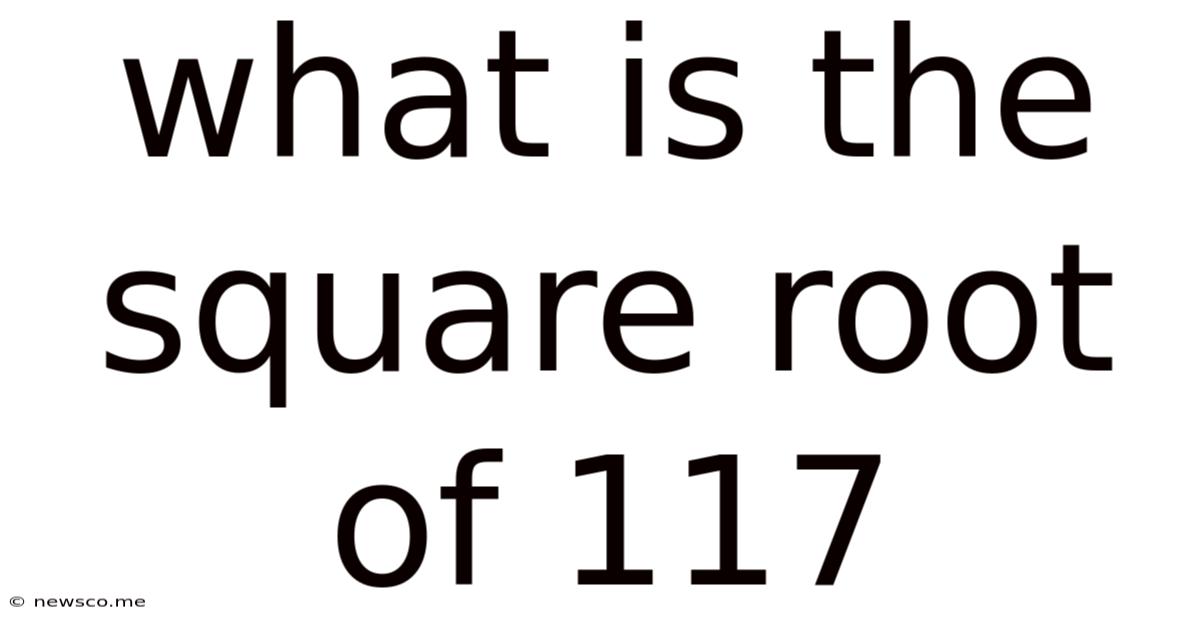What Is The Square Root Of 117
News Co
Mar 31, 2025 · 4 min read

Table of Contents
What is the Square Root of 117? A Deep Dive into Square Roots and Approximation Techniques
The question, "What is the square root of 117?" might seem simple at first glance. However, delving into its solution reveals a fascinating exploration of mathematical concepts, approximation techniques, and the nature of irrational numbers. This article will not only provide the answer but also unpack the underlying principles, demonstrating various methods to calculate the square root of 117 and similar numbers, making you comfortable with this fundamental mathematical operation.
Understanding Square Roots
Before we tackle the square root of 117, let's establish a firm understanding of what a square root actually is. The square root of a number is a value that, when multiplied by itself (squared), equals the original number. For instance, the square root of 9 is 3 because 3 * 3 = 9. We denote the square root using the radical symbol (√).
Key Concepts:
- Perfect Squares: Numbers that are the result of squaring an integer (e.g., 9, 16, 25). The square roots of perfect squares are integers.
- Irrational Numbers: Numbers that cannot be expressed as a simple fraction (a ratio of two integers). Their decimal representation is non-terminating and non-repeating. Many square roots are irrational numbers.
- Approximation: Since many square roots are irrational, we often need to approximate their values to a certain degree of accuracy.
Calculating the Square Root of 117
117 is not a perfect square. There isn't an integer that, when multiplied by itself, results in 117. Therefore, the square root of 117 is an irrational number. We can't find an exact decimal representation, but we can find increasingly accurate approximations.
Method 1: Using a Calculator
The simplest method is to use a calculator. Most calculators have a square root function (√). Simply input 117 and press the square root button. The calculator will provide an approximation, typically accurate to several decimal places. You'll find that:
√117 ≈ 10.8166538264
Method 2: Prime Factorization and Simplification
While we can't find a perfect square root, we can simplify the radical expression using prime factorization. Let's break down 117 into its prime factors:
117 = 3 x 3 x 13 = 3² x 13
Therefore, √117 = √(3² x 13) = √3² x √13 = 3√13
This simplified form is often preferred in mathematical contexts because it's exact, even though √13 is still irrational.
Method 3: Babylonian Method (Iterative Approximation)
The Babylonian method, also known as Heron's method, is an iterative algorithm for approximating square roots. It's based on repeatedly refining an initial guess.
Steps:
- Make an initial guess: Let's guess that the square root of 117 is close to 11 (since 11² = 121).
- Improve the guess: Divide 117 by the guess (117/11 ≈ 10.636) and average the result with the original guess: (11 + 10.636)/2 ≈ 10.818
- Repeat: Use the new guess (10.818) and repeat step 2. The more iterations you perform, the closer you get to the actual square root.
Let's do one more iteration:
117/10.818 ≈ 10.8167 (10.818 + 10.8167)/2 ≈ 10.81735
As you can see, the approximation is already quite close to the value obtained from a calculator. The Babylonian method converges quickly to the correct value.
Method 4: Newton-Raphson Method
Similar to the Babylonian method, the Newton-Raphson method is a powerful iterative technique for finding approximations of roots of functions. For finding the square root of a number 'x', we can apply the Newton-Raphson method to the function f(y) = y² - x. The iterative formula is:
y_(n+1) = y_n - f(y_n) / f'(y_n) = y_n - (y_n² - x) / (2y_n) = (y_n + x/y_n) / 2
This is essentially the same formula as the Babylonian method.
Understanding the Irrational Nature of √117
The square root of 117 is irrational, meaning its decimal representation goes on forever without repeating. This is a fundamental property of many square roots, especially those of non-perfect squares. Irrational numbers are a fascinating part of mathematics, highlighting the richness and complexity of the number system. Understanding their nature is crucial for a complete grasp of mathematical concepts.
Applications of Square Roots
Square roots are fundamental to various areas of mathematics and its applications:
- Geometry: Calculating distances, areas, and volumes often involves square roots (e.g., using the Pythagorean theorem).
- Physics: Many physical phenomena involve square roots, such as calculating velocities and energies.
- Engineering: Engineering designs frequently rely on square root calculations for structural analysis and other applications.
- Computer Science: Algorithms and computations frequently utilize square roots in various applications.
- Statistics: Standard deviation calculations in statistics rely on square roots.
Conclusion
While a simple calculator readily provides an approximation of the square root of 117 (approximately 10.81665), understanding the methods behind calculating this value offers a deeper appreciation for mathematical principles. Whether employing prime factorization for simplification, the iterative Babylonian method, or the more general Newton-Raphson technique, we've explored multiple approaches to tackling this seemingly straightforward question, revealing the rich landscape of mathematical concepts involved in finding square roots and dealing with irrational numbers. This understanding extends far beyond a single calculation, laying a strong foundation for tackling more complex mathematical problems and solidifying your comprehension of numerical systems. Remember, the beauty of mathematics often lies in understanding the "why" behind the "what."
Latest Posts
Related Post
Thank you for visiting our website which covers about What Is The Square Root Of 117 . We hope the information provided has been useful to you. Feel free to contact us if you have any questions or need further assistance. See you next time and don't miss to bookmark.